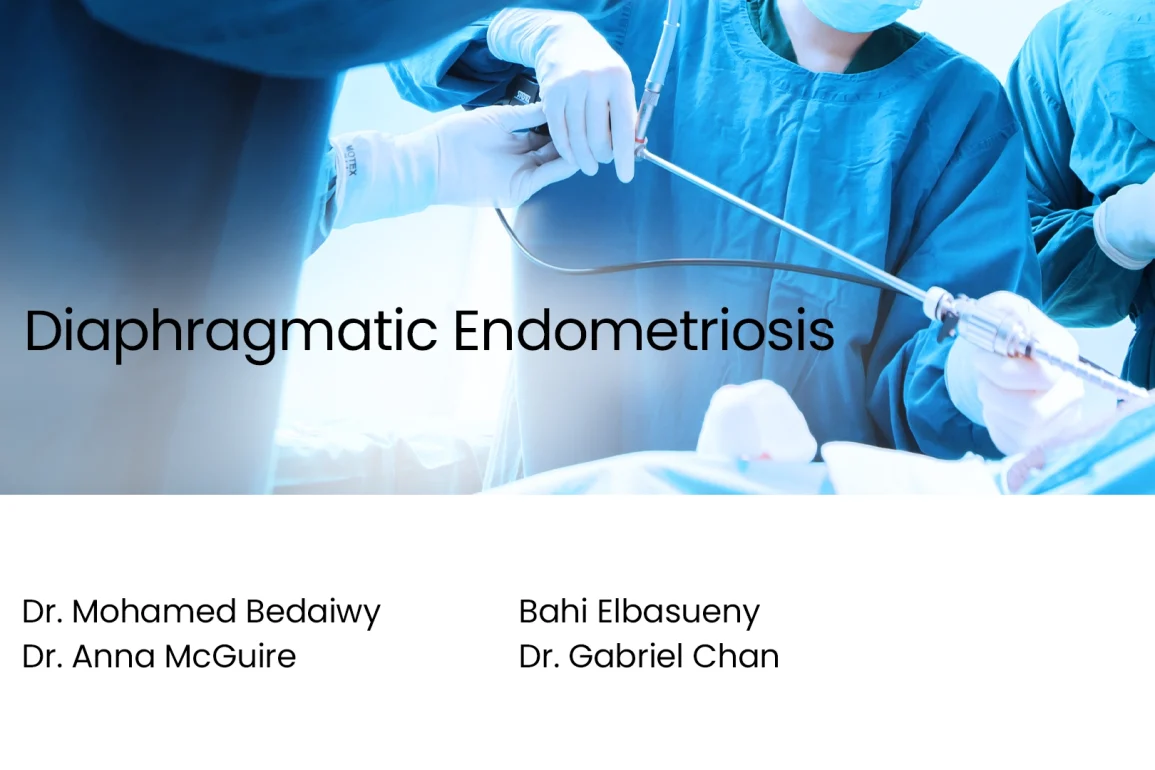Table of Contents
- Procedure Summary
- Authors
- Youtube Video
- What is Diaphragmatic Endometriosis?
- What are the Risks of Diaphragmatic Endometriosis?
- Video Transcript
Video Description
Watch two contrasting cases of diaphragmatic endometriosis—one treated with superficial excision, the other requiring full-thickness resection of the diaphragm.
Presented By




Affiliations
Not applicable
Watch on YouTube
Click here to watch this video on YouTube.
What is Diaphragmatic Endometriosis?
Diaphragmatic endometriosis is a rare form of thoracic endometriosis where endometrial tissue implants on the diaphragm, sometimes extending into the pleural space or lung. It typically presents later than pelvic disease, with a mean age of around 35, and is often associated with pelvic endometriosis. Symptoms may include cyclical right upper quadrant or shoulder pain, pneumothorax, hemothorax, hemoptysis, or pleural effusion, often occurring in relation to the menstrual cycle. Diagnosis is challenging because imaging may be negative and lesions can be hidden beneath the liver. Laparoscopy is the gold standard for detection, using a 30-degree scope, reverse Trendelenburg positioning, and liver retraction to expose the diaphragm.
Stepwise Surgical Approach: Surgery is reserved for patients who fail medical therapy or have severe symptoms. Lesions are first exposed by taking down adhesions between the liver and diaphragm. The peritoneum around the lesion is scored with monopolar cautery to define margins. Traction is applied to the nodule while the underlying diaphragm muscle is carefully dissected. Superficial lesions may be excised with monopolar or bipolar energy, while deep infiltrating disease may require full-thickness diaphragmatic resection with entry into the pleural cavity. Any pleural defects are closed with interrupted sutures. A multidisciplinary team, including gynecology and thoracic surgery, is essential for cases requiring combined abdominal and thoracic procedures.
This targeted surgical strategy allows complete removal of diaphragmatic lesions, reduces pain, and addresses the risk of thoracic complications while preserving diaphragmatic function.
What are the Risks of Diaphragmatic Endometriosis?
Surgical management of diaphragmatic endometriosis carries several potential complications:
- Pleural Complications: Entry into the pleural cavity during full-thickness resection can cause pneumothorax, hemothorax, or pleural effusion, occasionally requiring chest tube placement.
- Respiratory Symptoms: Postoperative pneumothorax may occur even without pleural entry and may require observation or drainage.
- Bleeding: The diaphragm is highly vascular, and dissection near major vessels can lead to significant hemorrhage.
- Injury to Adjacent Organs: The liver, lung, and phrenic nerve are at risk during retraction or resection, and inadvertent injury can cause pain, impaired diaphragmatic movement, or prolonged recovery.
- Persistent or Recurrent Pain: Even after complete excision, pain may persist due to central sensitization or microscopic disease.
- Delayed or Missed Diagnosis: Negative histology does not rule out endometriosis, and immunohistochemistry may be required to confirm estrogen and progesterone receptor positivity.
Despite these risks, a meticulous laparoscopic technique combined with a multidisciplinary team approach allows safe removal of lesions, effective symptom relief, and preservation of diaphragmatic integrity.
Video Transcript:
Two cases of diaphragmatic endometriosis. Diaphragmatic endometriosis is a condition that is part of the thoracic endometriosis syndrome, which is endometriosis of the diaphragm, pleural space, and lung parenchyma. Symptoms include catamenial pain, pneumothorax, hemothorax, pleural effusion, hemoptysis, and pulmonary nodules. The mean age of incidence is 35 years, which is later than the incidence of pelvic endometriosis.
Patients typically have pelvic pain prior to thoracic symptoms, and 50 to 84% of patients with diaphragmatic endometriosis also have pelvic endometriosis. History is important in establishing a diagnosis, and definitive diagnosis is by laparoscopy. Imaging is not always helpful. Diagnosis is often delayed even after laparoscopy, because disease can be hidden by the liver.
Medical therapy is first line for management, similar to pelvic endometriosis. If surgery is needed, a multidisciplinary team approach, including radiology, anaesthesiology, thoracic surgery, and gynaecology is important. Surgical procedures include video-assisted thoracoscopic surgery for thoracic lesions, and laparoscopy for diaphragmatic lesions.
Our first case is a 35-year-old gravida 2, para 2, with catamenial right upper quadrant pain. CT was unremarkable. She had prior surgery for congenital intestinal malrotation, and pathology confirmed endometriosis at the time. She also had evidence of central sensitisation, and had failed multiple attempts with medical therapies.
She was diagnosed with likely diaphragmatic endometriosis, and was consented for total laparoscopic hysterectomy, excision of endometriosis, and possible excision of diaphragmatic endometriosis. She also saw thoracic surgery, who recommended concurrent possible video-assisted thoracoscopic surgery.
Initial survey of the abdomen did not reveal any endometriosis until the liver was retracted. Adhesions between the diaphragm and the liver can be seen here, and were taken down with the monopolar hook cautery. The diaphragm was then scorched circumferentially around the lesion. Traction was applied to the lesion, and the striated muscle of the diaphragm could be seen underneath, as shown here.
This endometriosis lesion was deep infiltrating, and required full thickness resection of the diaphragm. Here you can see the window created into the pleural cavity, and the lower right lobe of the lung can be seen through this window. The endometriosis was completely resected and removed, and a liver retractor was placed. The laparoscope advanced into the pleural cavity. There were no pleural endometriosis lesions seen as shown here.
The diaphragm was then closed with three interrupted horizontal mattress sutures with 0 Ethibond sutures. Her post-operative recovery was unremarkable. She had a small apical pneumothorax that was managed conservatively without the need of a chest tube, and was discharged on Post-Op Day 2. Pathology results of the diaphragmatic nodules were negative for endometriosis. According to the ESHRE guideline, negative histology does not rule out endometriosis.
A recent review article of diaphragmatic endometriosis used an inclusion criteria of direct inspection surgically, and cases were not excluded if histology was negative. Furthermore, there was a case report showing endometriosis which was negative with basic histology, but the sample was positive for oestrogen and progesterone receptors with immunohistochemistry.
Another study of 55 cases found that only one case of thoracic endometriosis was positive, with basic histology, and 67.3% of the cases were only oestrogen and progesterone positive with immunohistochemistry.
Therefore negative pathology does not rule out endometriosis. She was seen in follow-up at six weeks and at 11 weeks, and had ongoing right upper quadrant pain. She was rereferred to thoracic surgery for assessment and started on hormonal therapy.
Our second case is a 44-year-old with longstanding history of endometriosis and chronic pelvic pain. She had a remote history of laparoscopic myomectomy for fertility, and was noted to have superficial endometriosis at that time, which were removed. She was taking cyclic oral contraceptives, and had right upper quadrant pain on history that was not responsive to medical management.
She did not have any imaging of her chest. A nodule was seen in the right hemidiaphragm. Monopolar hook cautery was used to score the peritoneum circumferentially around the lesion. Chocolate cyst-like fluid was seen. Traction was applied, and cautery was used to undermine the lesion.
Ligature was used to bluntly separate the nodule from the muscle of the diaphragm, and identify the dissection plane. Tissue pillars were taken down with the ligature. Care was taken to not enter the plural cavity. The endometriosis lesion was completely excised without entry into the pleural cavity. The diaphragm nodule was positive for endometriosis. She had an unremarkable recovery, was discharged on Post-Op Day 1, and had resolution of pain at the six week follow-up.
In conclusion, diaphragmatic endometriosis may be difficult to diagnose. Imaging may be negative, and lesions may be obscured by the liver surgically. Use of a 30 degree laparoscope, and reverse Trendelenburg, and a liver retractor can help identify lesions. Multidisciplinary approach in the OR is important if diaphragmatic endometriosis is suspected.


